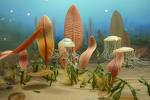 |
 |
 |
 |
 |
Produced
by the Population Genetics and Evolution class, Furman University |
||||
 |
 |
 |
 |
 |
Produced
by the Population Genetics and Evolution class, Furman University |
||||
 |
The
Ediacaran: Arkarua |
 |
Arkarua
adami is a small disc shaped fossil, which
has been identified as the earliest echinoderm. The classification was
made because the fossil has a five-lobed central region, which can be
interpreted as the five ambulacral grooves characteristic of echinoderms
(Gehling 1987). Arkarua lacks a stereom or water vascular system, which
makes their distinction as an echinoderm uncertain. It was first discovered
in the Flinders Ranges in southern Australia, along with Dickinsonia,
Tribrachidium, Cyclomedusa, and other Ediacaran animals
(Taylor 2005). There is some difficulty in assessing the development
of the first echinoderms, seeing as other stem groups, such as Hemalazoans
and Helicoplacoidea, are not pentaradial but have a stereom. Page by Megan Aprill |
 |
| Arkarua from the website of Prof. Giuseppe L. Pesce, Università dell'Aquila | |
| Gehling, JG. 1987. Earliest known echinoderm — a new Ediacaran fossil from the Pound Subgroup of South Australia. Alcheringa 11:337-345. Taylor, C. 2005. Arkarua: All that is pentaradial is not Echinoderm. www.paleos.com. Accessed January 24, 2010. The Virtual Fossil Museum. Phylum Echinodermata. Accessed January 24, 2010. |